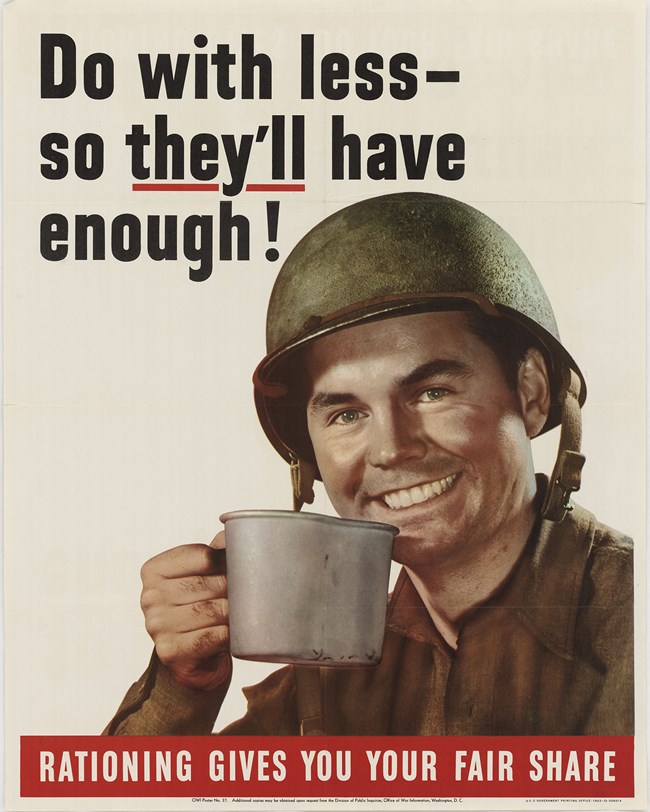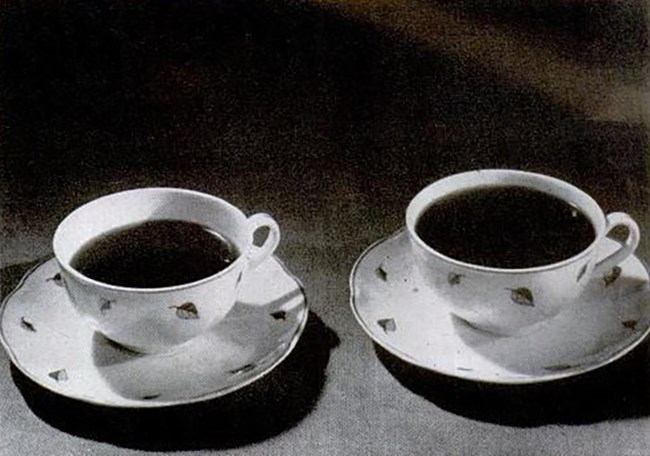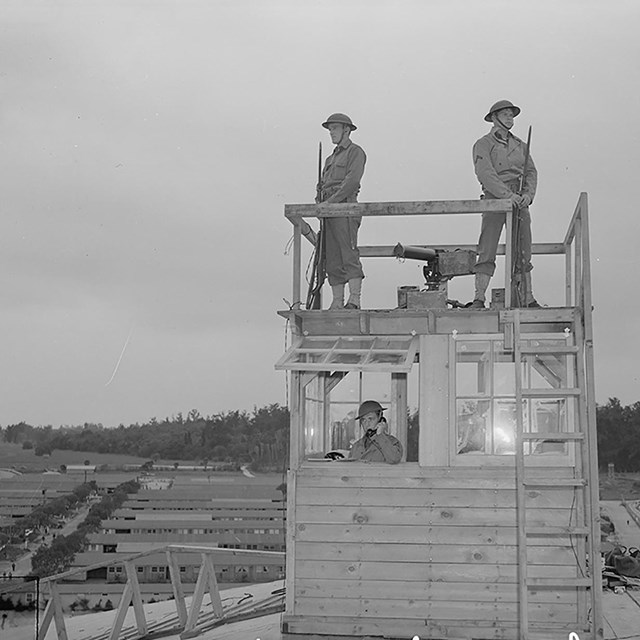Last updated: November 16, 2023
Article
Coffee Rationing on the World War II Home Front

Collection of the National Archives and Records Administration (NAID: 513838).
Coffee was rationed from November 1942 to July 1943.[1] There were bumper crops of coffee in Central and South America at the start of the war. But U-boat attacks on cargo ships and the diversion of cargo capacity for the war meant that a lot of it wasn’t making it to the US. The coffee that did arrive – including instant coffee -- was prioritized for the military.[2]
To manage the shortage, the government first tried limiting how much coffee roasting companies could use. In April 1942 they imposed a limit of 75% of the previous year’s amount. In September, they lowered the limit to 65%. Consumer demand stayed high – even though supply fell, consumer demand stayed at pre-war levels of about 20 pounds per person per year. The only solution was for the Office of Price Administration (OPA) to ration coffee, which they did, beginning at the end of November, 1942.[3]
To help prevent hoarding sales of coffee were halted for a week before rationing began on November 29, 1942. The OPA designated a set of stamps in Ration Book One (the “Sugar Book”) for coffee purchases. At first, every adult over the age of 15 could get one pound of coffee every five weeks (about 10.5 pounds per year). In February 1943, that ration was reduced to one pound every six weeks (slightly over 8.5 pounds per year). This made less than one cup a day for coffee drinkers. Before rationing, they had been used to one to two cups per day on average.[4]
To help people manage the coffee shortage, magazines like Life published articles on how to make the best cup of coffee possible, and how to stretch the coffee they could get. The authors compared brewing methods to get the most coffee from grounds (boiled coffee yielded the most; percolated yielded less; and drip coffee produced the least) and gave tips on stretching coffee rations.[5]

Life Magazine, November 30, 1942, p. 68.
Although it was technically illegal, those who did not drink coffee shared or sold their coffee coupons.[6] Methods for stretching coffee included:
-
Reducing the amount of coffee in a cup. By reducing the amount of coffee poured into a cup, “four cups can serve five.” This method was also used by restaurants and coffee shops.[7]
-
“Double Dripping.” Pouring water over used coffee grounds will give you an additional 30% yield. If using a percolator, longer percolation would also give 30% more coffee, but it makes it bitter.[8] Some called coffee made using reused grounds “Roosevelt coffee” after the president.[9]
-
Adding chicory. Chicory is a caffeine-free herb introduced to North America from Europe in the 1700s. Chicory coffee is made from the roasted root, which has a nutty and slightly bittersweet taste. It was popular in the Civil War, when coffee was not easily available.[10] A Life Magazine article from 1942 recommended adding one-half ounce of chicory to one pound of coffee to stretch it 30% without much altering the taste.[11]

Wikimedia
Other coffee substitutes or stretchers included those made from roasted grains like barley and other ingredients. Postum, made with roasted wheat bran, wheat, and molasses, was probably the most well-known in the United States.[12]
Like other rationed goods, just because you had a ration coupon didn’t mean coffee was available. Some grocers would take names of those wishing to buy coffee and contact them when it was available. At other grocers, it was hit or miss. One grocer broke the seals on vacuum-packed coffee to prevent people from hoarding – once exposed to air, coffee had to be used relatively quickly. Restaurants who served customers bottomless cups of coffee before the war limited them to a single cup during rationing.[13]
Coffee rationing ended on July 28, 1943. In September 1944, the OPA raised the price of coffee to help control the demand. It worked, and they did not have to re-institute coffee rationing.[14]

Collection of Duke University Libraries, David M. Rubenstein Rare Book & Manuscript Library (ark:/87924/r3930p504).
This article was written by Megan E. Springate, Assistant Research Professor, Department of Anthropology, University of Maryland, for the NPS Cultural Resources Office of Interpretation and Education. It was funded by the National Council on Public History’s cooperative agreement with the National Park Service.
[1] Ames History Museum n.d.; Weber and Handley 2016.
[2] The military considered coffee essential because it helped keep troops awake and increased morale. After the US entered the war, the US military’s coffee consumption was ten times more than before. Lokker 2013; Rothfeld 2022; Sundin 2022; Weber and Handley 2016.
[3] Life Magazine 1942: 64; Lokker 2013; Rothfeld 2022; Sundin 2022.
[4] Life Magazine 1942: 64; Sundin 2022.
[5] Life Magazine 1942: 64.
[6] Sundin 2022.
[7] Life Magazine 1942: 66.
[8] Life Magazine 1942: 66.
[9] Sundin 2022.
[10] Donaldson and Mazet 2013; Tobin 2023; Weber and Handley 2020.
[11] Life Magazine 1942:66. Chicory-coffee blends are popular in New Orleans and elsewhere around the world. New Orleans is an American World War II Heritage City.
[12] Sundin 2022.
[13] Life Magazine 1942: 68-70.
[14] Sundin 2022.
Ames History Museum (n.d.) “Rationed Goods in the U.S. During World War II.” Ames History Museum.
Donaldson, S. and Wendy Hanson Mazet (2013) “A Northern Nevada Homeowner’s Guide to Identifying and Managing Chicory.” Extension University of Nevada, Reno.
Life Magazine (1942) “Coffee Rationing: Hints on How to Make A Good Brew and Stretch the Available Supply.” Life Magazine, November 30, 1942, p. 64-70.
Lokker, Brian (2013) “U.S. Coffee Rationing in World War II.” Coffee Crossroads, January 13, 2013 (updated June 22, 2020).
Rothfeld, Anne (2022) “Coffee Rationing During World War II.” Circulating Now: From the Historical Collections of the National Library of Medicine, November 23, 2022.
Sundin, Sarah (2022) “Make It Do: Coffee Rationing in World War II.” Today in World War II History, November 21, 2022.
Tobin, Taylor (2023) “What Is Chicory Coffee and Why Is It So Popular in New Orleans?” Southern Living, April 28, 2023.
Weber, Camille and Lauren Handley (2016) “Home Front Friday: Coffee Takes A Cut.” See & Hear: Museum Blog, The National WWII Museum, July 8, 2016.
Table of Contents
1. Introduction
2. The American Home Front Before World War II
3. The American Home Front and the Buildup to World War II
3B The Selective Service Act and the Arsenal of Democracy
4. The American Home Front During World War II
4A A Date That Will Live in Infamy
4A(i) Maria Ylagan Orosa
4C Incarceration and Martial Law
4D Rationing, Recycling, and Victory Gardens
4D(i) Restrictions and Rationing on the World War II Home Front
4D(ii) Food Rationing on the World War II Home Front
4D(ii)(a) Nutrition on the Home Front in World War II
4D(ii)(b) Coffee Rationing on the World War II Home Front
4D(ii)(c) Meat Rationing on the World War II Home Front
4D(ii)(d) Sugar: The First and Last Food Rationed on the World War II Home Front
4D(iii) Rationing of Non-Food Items on the World War II Home Front
4D(iv) Home Front Illicit Trade and Black Markets in World War II
4D(v) Material Drives on the World War II Home Front
4D(v)(a) Uncle Sam Needs to Borrow Your… Dog?
4D(vi) Victory Gardens on the World War II Home Front
4D(vi)(a) Canning and Food Preservation on the World War II Home Front
4E The Economy
4E(i) Currency on the World War II Home Front
4E(ii) The Servel Company in World War II & the History of Refrigeration
5. The American Home Front After World War II
5A The End of the War and Its Legacies
5A(i) Post World War II Food
More From This Series
-
 The Home Front During World War IIIncarceration and Martial Law
The Home Front During World War IIIncarceration and Martial LawThe US government incarcerated many Americans and others in camps and prisons across the country. Martial law was declared in Hawaii.
-
 The Home Front During World War IIFood Rationing
The Home Front During World War IIFood RationingThe military's need for food and packaging, limited shipments from overseas, and agricultural laborers going to war meant food was rationed.
-
 The Home Front After World War IIPost World War II Food
The Home Front After World War IIPost World War II FoodWorld War II changed what and how Americans eat -- from a taste for military rations and foreign food to processed foods and candy.
